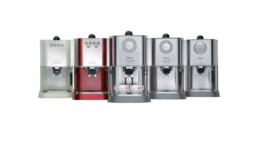Gaggia Baby
Baby is the first household espresso machine from Gaggia marketed in 1977. After 30 successful years it had remained relatively un-touched. That was until Rezzonico Design was asked to re-design the Baby for the 21st Century.
Client
Gaggia
Service
Design
Year
2005
How do you re-design a cultural Icon?
“The goal was not to change the Baby, but make it new again,” says Fabio Rezzonico about his role in the re-design.
“We began by analyzing the original and deciding what was iconic and what could be changed.” Through a series of presentations and meetings with Gaggia they analyzed the Baby and outlined it’s future form.
The design team also explored how the new Baby could be re-interpreted with different processes and materials. Rezzonico explains, “Design has changed so much since the Baby was introduced in the mid seventies. We wanted to give value to the original design without changing it drastically. We did this by applying traditional and valuable materials like stainless steel, aluminum, and polished plastic.”
The design proceeded until a balance between old and new was met. “The basic forms of the body may seem identical, but there are many changes. The materials and interfaces are all new. It has a balance now between retro and modern, meeting our design goals,” says Rezzonico.
When designing the interfaces they allowed for more liberty.
“There are many versions of the New Baby so we decided that in some of these versions we could add in more technology,” says Rezzonico. There are 5 versions that go from the most basic technology, similar to the original baby, to advanced capacitive interface technology. “The capacitive interface is the most technically advanced that is used on this kind of appliance. It is most often used in stereo and MP3 players, so we thought it would be an exciting fit,” Rezzonico says. The capacitive interface senses heat and pressure, it is a touch technology that keeps the surface completely flat, modern and easy to clean. Rezzonico describes it as “simple to use, and at the same time very innovative.” However, one could choose a Baby on the other end of the product range, in plastic with traditional button technology. “We liked that through this range someone could choose how technologically advanced they wanted their coffeemaker, there was something for the Traditionalists as well as the Futurists,” explains Rezzonico. (Or Techno-Enthusiasts or cutting edge)
As the new Baby product range begins a new chapter in the iconic coffeemaker’s history Rezzonico believes that the baby will continue it’s success, “It is a product that people love, we hope that the re-design reinforces that and adds a new dimension to the Baby for the next thirty years.”

